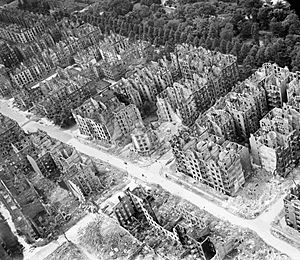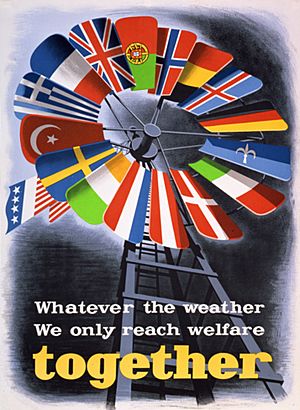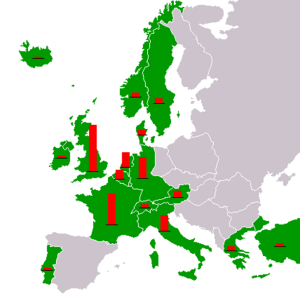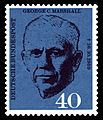Marshall Plan facts for kids
The Marshall Plan was a big plan by the United States to help rebuild countries in Europe after World War II. It was officially called the European Recovery Program (ERP). A main goal of the plan was to stop the spread of communism, which was a political idea where the government controlled everything.
The plan was named after George Marshall, who was the Secretary of State for the United States. However, many other people in the government helped create the plan.
The Marshall Plan lasted for four years, starting in April 1948. During this time, the U.S. gave about US$13 billion in money and technical help. This aid went to European countries that were part of the Organization for European Economic Co-operation.
By the time the plan ended, the economies of these countries had grown much stronger than they were before the war.
Some historians today also believe the plan helped the United States become more powerful. They say it made Western European countries rely on the U.S. They also point out that the United Nations Relief and Rehabilitation Administration helped millions of people from 1944 to 1947. This group also played a part in Europe's recovery after the war.
Contents
Other Ideas Before the Marshall Plan

Before the Marshall Plan, there were other ideas about how to help Europe. Some of these ideas focused on Germany, which had caused much of the war's destruction.
The Morgenthau Plan
Henry Morgenthau, Jr. was the U.S. Treasury Secretary. He suggested that if Europe needed money to rebuild, they should take it from Germany. This money was called war reparations. Morgenthau also thought this would stop Germany from ever becoming strong enough to start another war.
However, taking money from Germany after World War I did not work well. Instead of helping other countries, it hurt them. For example, companies could not sell their own coal and steel because Germany was giving it away for free.
The Monnet Plan
Jean Monnet from France had a different idea. He thought France should control Germany's coal areas, like the Ruhr and Saar. France could then use this coal to rebuild its own industries.
In 1946, the countries that occupied Germany agreed to limit how quickly Germany could rebuild its industries. They put limits on how much coal and steel Germany could produce.
The Level of Industry Agreement
This was the first plan for German industry. It was signed in early 1946. It said that Germany's heavy industry should be cut down to half of what it was in 1938. This was done by destroying about 1,500 factories.
By late 1946, governments saw problems with this plan. The agreement was changed several times, even up to 1949. But factories continued to be taken apart until 1950.
Germany had been very important to Europe's economy for a long time. A poor Germany meant that other European countries could not sell as many goods to Germany. This held back Europe's overall recovery. Also, a poor Germany was expensive for the countries occupying it. They had to provide Germany with food and other things it needed.
Because of these problems, the Morgenthau and Monnet plans were not chosen.

The Marshall Plan ended in 1952. Ideas to continue it were stopped because of the high cost of the Korean War. Also, some U.S. politicians who did not like the plan gained more power in the 1950 elections.
Was the Marshall Plan Selfish?
The Marshall Plan has often been called "the most unselfish act in history." However, some people disagree. The United States also gained from the plan. One part of the agreement was that countries receiving aid had to open their economies to U.S. companies.
Some historians, like Walter LaFeber, have said that the plan was a form of American economic imperialism. This means it was an attempt for the U.S. to gain control over Western Europe. They compare it to how the Soviet Union controlled Eastern Europe.
Economist Tyler Cowen has pointed out that countries that received the most aid from the Marshall Plan, like Britain, Sweden, and Greece, grew the least between 1947 and 1955. Countries that received less aid, like Austria, grew the most.
When looking at West Germany's economy, German analyst Werner Abelshauser found that foreign aid was not necessary to start or continue its recovery. Cowen also found that the economies of France, Italy, and Belgium began to recover before the Marshall Plan started. Belgium, for example, used free market economic policies after it was freed in 1944. It had the fastest recovery and did not suffer from the severe housing and food shortages seen in other parts of Europe.
Images for kids
-
General George C. Marshall, the 50th U.S. Secretary of State
See also
 In Spanish: Plan Marshall para niños
In Spanish: Plan Marshall para niños









